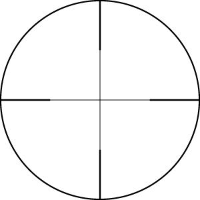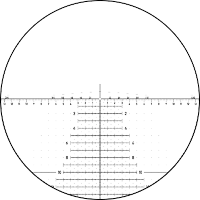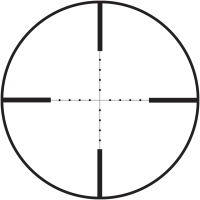

Reticles
Reticles of all shapes, makes, applications and sizes what they are good for and what situations they are suited for.
Table of Contents
Reticles, also referred to as crosshairs, are a set of fine lines or markings built into the optics of a scope or telescopic sight for the purpose of aligning the scope and therefore firearm with the target.
The simple crosshair in the shape of a “+” is but one of many reticle patterns that exist in modern scopes.
Thought to have been invented by William Gascoigne, an English amateur astronomer in the late 1630’s. He found that a spider’s web spun at a precise point between two lenses allowed him to align the telescope with precision.
Scope Focal Planes

FFP (First Focal Plane) Reticles
The reticles located at the FFP change in size when you change the power or zoom on the scope. The beauty of this reticle is that the subtensions (the distance between two points on the target) remain the same regardless of the scope power setting.
FFP Common use Cases
- Long range shooting
- Some match shooting
- Military
- Police

Pro's
- Subtensions remain accurate
- Better wear and tear
Con's
- Markings are hard to see at low power
- Tends to cost more
SFP (Second Focal Plane) Reticles
The reticles located at the SFP remain the same size when you change the power or zoom on the scope. The subtensions on the SFP reticle are only accurate at one power (zoom) setting, generally maximum power . The advantage of this reticle is that the fine markings can be seen regardless of the scope power setting.
SFP Common use Cases
- Hunting
- Sports

Pro's
- Markings are easy to see at any power
- Usually cheaper
Con's
- Subtensions only accurate at one power setting
- Less durable
Regardless of reticle, FFP or SFP, the center crosshair is always accurate.
Tim
Which Focal Plane Reticle is the Best?
The most common reticle by a decent margin is the SFP reticle. However, the choice, essentially, is a personal preference. It will depend on the type of target and range you intend to use it for, amongst other factors.
Most manufacturers of modern scopes give you a choice of SFP and FFP reticles to choose from.
If money were no object then my personal choice is likely leaning toward high quality FFP reticles.
Tim
Illuminated Reticles
Illumination of reticles greatly aid vision at night and low light conditions. This can be achieved by fiber optics or plastic piping to gather and enhance ambient light. Batteries also are used to power LED reticles. These are typically red in color so as not to destroy night vision. The radioactive properties of tritium are also used to illuminate reticles.
Reticle Shapes
There are literally thousands of different reticle shapes. Every scope manufacturer has adopted the classic styles as well as developing their own custom array of reticle shapes.






Bullet Drop Compensator (BDC)
A scope with a bullet drop compensator is an optic that uses either a:
- Reticle which has marks down the vertical axis similar (but not the same) to Mil-Dot markings to visually adjust the aim point dependent on distance to the target.
- Dedicated turret to pre-calculate the distance that a bullet drops over the distance to the target.
BDC’s are cartridge dependent. Change the cartridge = change the BDC. Altitude and temperature (Air Density) is also a factor. To give you an idea of what is involved in properly calibrating a BDC I have included this link to Berger Bullets Ballistics Calculator.
The G7 ballistic coefficient is an improved version of the G1 calculation. It is usually included to give reference to older bullet types.
Tim
With BDC’s ask about, some people love them and others wouldn’t touch them with a ten foot pole. All a bit fussy for hunting in this authors opinion, I prefer using Mil-Dot reticles which I find far more versatile.


You get some idea of the complexities involved in BDC reticles from the video below. I also gather our mate presenting the clip is NOT a fan!